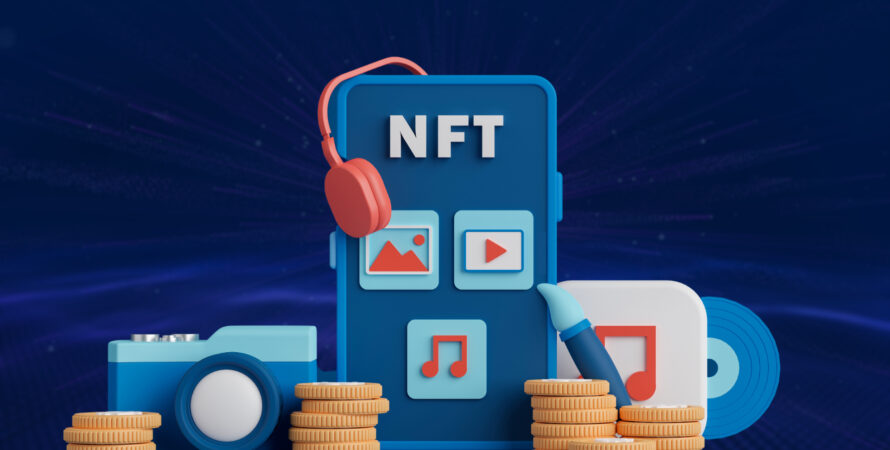- NFT minting comes up with upfront costs that can put off some artists.
- Lazy Minting is a unique feature some marketplaces provide where the buyer covers the gas fees.
- Popular platforms that support Lazy Minting are OpenSea, Rarible and Mintable.
NFTs have been in the crypto market since 2014, when Quantum, the first-ever NFT was launched. Since then, many NFTs have been created and sold, but they all remained in the circles of crypto geeks and the growing, but gradually, NFT community. NFTs became a mainstream word when Beeple, an NFT artist, sold his “Everyday – The first 5000 Days” digital art for a whopping $69 Million in an auction.
This was a hot topic for several days, with several media channels covering the auction, and NFTs now no longer could be ignored. Bored Ape Yacht Club by Yuga Labs is credited with the first NFT collection to draw in celebrities and give rise to pop culture phenomenon. Along with Art, Music, and Video, NFT-based virtual worlds like Decentraland and gaming platforms like Axie Infinity also gained popularity.
NFT Minting and Upfront Costs
This widespread popularity of NFTs drew many artists to blockchain platforms to create their NFTs, hoping to sell them at huge profits. Ethereum was the most common NFT platform. However, the artists still faced some challenges. Minting an NFT on blockchain included some upfront expenses to be paid by the artist.
Gas fees: This fee is paid to the blockchain network to validate the transaction and use it to store our NFT. This price generally varies with the blockchain and congestion at that time, still, it can range from $1 to $1000
Listing Fees: Some marketplaces charge money upfront to list your NFTs on their website and make them visible to potential buyers.
Account Fees: NFT marketplace and creation tools charge an account fee to set up an account and use their platform.
This was a clear hindrance for small and emerging artists. Thus, Lazy NFT Minting was introduced as a means of free and easy NFT minting.
What Is Lazy NFT Minting ?
Lazy minting is a feature that allows artists to produce an NFT for free without paying gas fees. However, he needs to mint the NFT when he finds a buyer, and the gas fees is included in the selling price.
This means the artist doesn’t pay any fees until he finds a buyer. The buyer pays some amount for the NFT, of which some percentage is deducted as gas fees, and the rest goes to the artist.
Working of Lazy Minting:
The artist creates a voucher and signs them with his private signature. The voucher has all the NFT data and smart contracts. The signature can be created using EIP-712, a standard for these digital signatures. They give the buyer proof that this artwork is created by an authorized artist.
The artist includes data like wallet address and TokenID in the voucher. This tells the buyer where to transfer the purchasing amount.
The buyer then transfers tokens from his wallet to the artist paying two fees. The gas fees for the transaction and the agreed selling price.
Advantages of Lazy Minting
For Artists:
Lazy minting is a cost-effective method for creating NFTs, attracting more artists in this field. They are not required to make up stock or commit a minimum number of NFTs in advance.
Gaming Industry: In the virtual gaming world, players can buy unique wearables, and fancy items for their avatars, making them unique and exclusive. The gaming company doesn’t need to buy and keep many such NFTs in stock. They can provide them on demand, decreasing their setting up cost.
Digital Art and Souvenirs: Lazy minting facilitates in on-demand NFT creation rather than producing a stock of 100 or 1000 NFTs. This helps in making exclusive and limited artworks, making them even rarer. Similarly, customized pieces with a personal touch can be made for buyers.
Popular Lazy Minting Platforms:
OpenSea:
One of the largest NFT marketplaces in the world with around 1.5 Million active users. It can support nearly 150 crypto tokens
Mintable:
The company came up with its own unique minting technology called Mintology. Artists without any coding language can easily work on its simple user interface. Along with Crypto tokens, you can use PayPal, Credit Cards and other payment methods supported on the platform.
Rarible:
Another marketplace that supports Lazy Minting and boasts of an optimized user interface.
Final Thoughts:
With new marketplaces and platforms supporting the Lazy Minting feature, new artists are also coming up and trying their luck in this domain. The upfront fees and prerequisite coding basics are no longer an obstacle in the path of creators.




